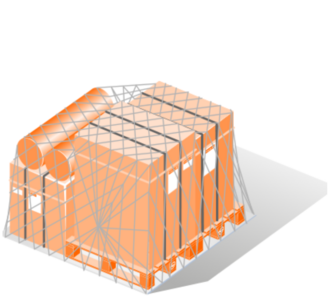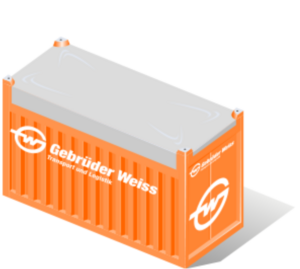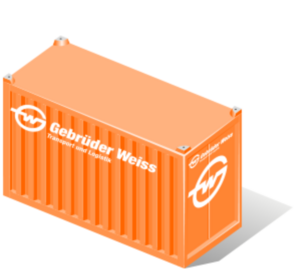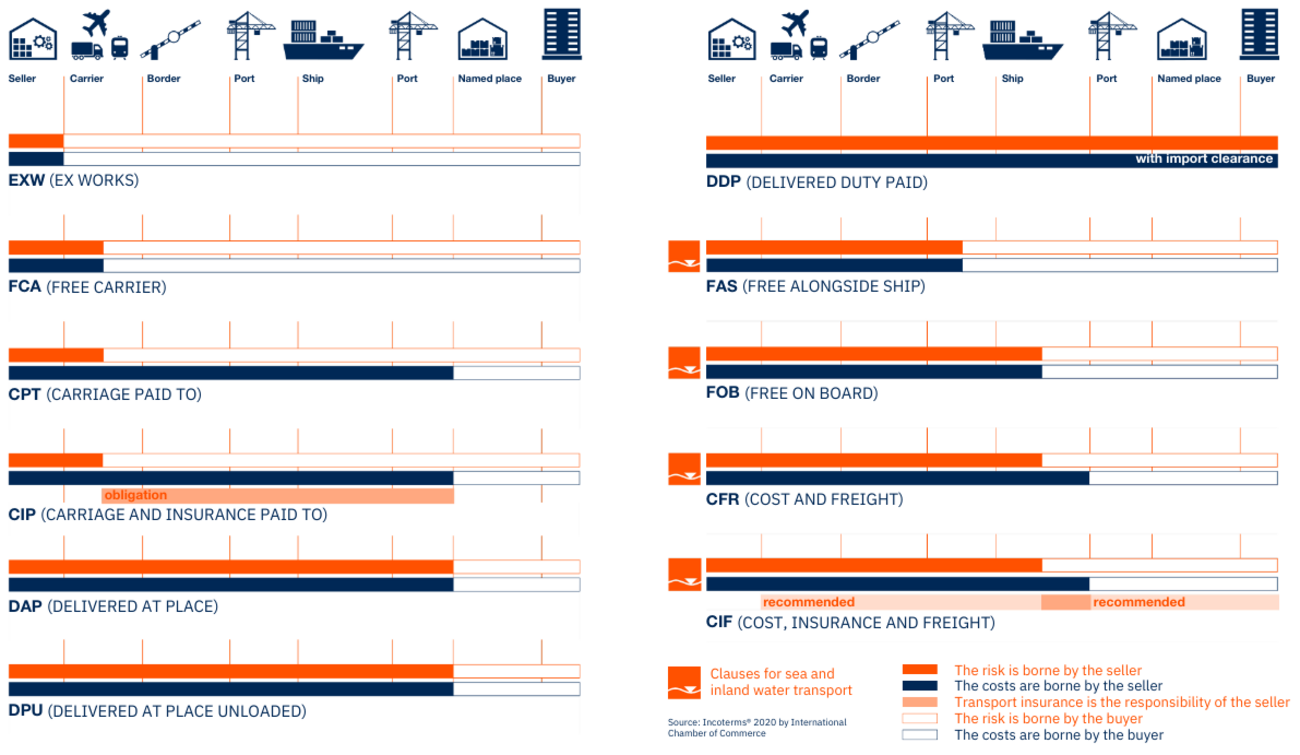Search

This page offers a comprehensive guide to international air and sea freight. Here, you will find all the necessary information about documents, transport regulations, and important technical terms in one place. As the world's oldest transport and logistics company, Gebrüder Weiss offers long-standing expertise, a strong global network, and a personal touch. Submit a transport request or contact our experts at a Gebrüder Weiss Air & Sea location near you.
Air freight must be fast, but what good is the fastest connection between two places if goods are delayed because of incorrect or missing paperwork? To avoid these kinds of problems, keep the following points in mind: Find all the relevant information on documents, types, and costs.
For intra-community deliveries within the EU, an invoice, delivery note, or packing list containing the following information will suffice:
For an air freight consignment, a commercial invoice and a packing list are generally sufficient as accompanying documents, though a copy of the bill of lading or air waybill may also be required. However, swift customs clearance is often only guaranteed if the goods are accompanied by the required customs documents. This saves time and money. For this reason, the documents required for customs purposes must be carefully checked before import, not least to take advantage of reduced customs tariffs where possible. The Gebrüder Weiss customs specialist can provide you with details on the applicable provisions at any time based on country lists and customs tariff documents.
If you are importing textiles or clothing, please note that a certificate of origin must be submitted for goods exceeding a specific customs value. Some goods are generally not allowed to be imported. An import permit may also be required for the import of textile goods from particular countries. In most cases, you can request an import permit before the consignment arrives if you request the correct documents from your supplier in a timely manner. The necessary documents depend on the country of origin and the trading country.
An air freight consignment must comply with the customs requirements of both the country of origin and the country of arrival. For this reason, air freight consignments may only be sent from (and to) airports that enable the necessary customs clearance. These airports are called "customs airports." If you are unsure whether the airport closest to your supplier or shipper is a customs airport, please contact us.
Depending on the destination and aircraft type, there are limits on the dimensions and gross weight of packaged items. With relatively large packaged items, it is sometimes just a matter of a few centimeters that determine whether the goods can be loaded onto the aircraft. Although height is the main factor, width and length can also make it impossible to transport items with a specific aircraft.
Maximum loadable heights (if length und width are OK) for some of the mot commonly used aircraft types
| Airbus 310, 330, 340, 380 | 160 cm |
| Airbus 320 | 114 cm |
| Boeing 737 | 86 cm |
| Boeing 747F (cargo plane) | 300 cm |
| Boeing 777F (cargo plane) | 300 cm |
| MD 80 | 70 cm |
| MD 11F (cargo plane) | 250 cm |
General recommendation:
| Within Europe max. | 70 cm |
| Overseas max. | 160 cm |

LD 7 container
approx. internal dimensions (l x w x h):
120.5 x 78.7 x 60.2 in

LD 3 container
approx. internal dimensions (l x w x h):
57.5 x 56.7 x 63 in

LD 9 refrigerated container
approx. internal dimensions (l x w x h):
119.3 x 82.7 x 57.1 in

AKH container
approx. internal dimensions (l x w x h):
57.5 x 56.7 x 43.7 in

AMJ container
approx. internal dimensions (l x w x h):
118.1 x 89.8 x 94.5 in

10 ft. pallet (PMC)
approx. basic dimensions (l x w):
125.2 x 96.1 in
approx. internal dimensions (l x w):
119.7 x 90.6 in
Prices are always quoted per kilogram or 6 dm³. This is also referred to as a volume ratio of 1:6, meaning that 1 m³ equals 167 kg. This means that you pay for either the weight or the space required to transport your shipment. Whether you pay for weight or space is calculated using the following equation:
Length x width x height [cm]
———————————— = Volumetric weight [kg]
6.000
Example 1
You are shipping one box that weighs 80 kg and measures 50 x 50 x 50 cm.
Example 2
You are shipping eight boxes with a total weight of 45 kg. All boxes are the same size (60 x 40 x 20 cm).
When exporting goods, it is important to ensure secure transport and payment methods. Gebrüder Weiss will gladly advise you on how to securely receive your money.
Thanks to Gebrüder Weiss Air & Sea's global partner network, shipping with COD is possible to almost every country in the world. For more information, please contact our Air & Sea specialists.
Be sure to note any special payment arrangements on the shipping order and include accompanying documents (L/C copies, bank and notify addresses, etc.). This is the only way to ensure that the transport documents can be issued in accordance with the relevant regulations.
As with road and sea freight, there are binding regulations that must be observed for air freight. But what constitutes dangerous goods?
People often overlook the fact that dangerous goods can be found in everyday items such as batteries and gas cartridges, or that promotional items such as lighters, matches and adhesives can contain dangerous goods. Some cosmetics are also classified as dangerous goods. This can have serious consequences:
In the case of air freight, if an accident occurs as a result of undeclared or incorrectly declared hazardous goods, the shipper bears sole liability for the resulting loss or damage.
Therefore, you must know the exact contents of your shipment! All dangerous goods must be declared using the Shippers Declaration for Dangerous Goods form and packaged in accordance with regulations.
The Shippers Declaration for Dangerous Goods must be signed by the sender and contains important information about the product, the prescribed packaging and the UN number (the product's hazardous goods identification number).
To declare hazardous goods, you need certain details, e.g.:
Regulations are subject to constant change, for example with regard to safety declarations or known consignors. Gebrüder Weiss has several specialists who can provide you with detailed information about the Dangerous Goods Regulations.
Safety regulations in air freight
For export shipments, an EU regulation currently requires a written safety declaration in order to be recognised as a 'known consignor'. (Current EU regulations must be observed; the legal framework may change). For up-to-date information, please contact your local Air & Sea office.
| 3-letter airport abbreviation (e.g. JFK) |
Freight forwarder handling air freight
Air consignment note
Abbreviation for Automated Manifest System (automated information for customs authorities)
Aircraft cargo space underneath the passenger deck
Confirmation of the airline, mainly requested by Arab customers in the letter of credit
List of airlines banned within the EU
Customs warehouse
Airline
A leased aircraft or leased cargo space
Grouped air freight shipment
Customs clearance agent
Airport of entry
Delivery of the goods and the transport documents to the airline
Articles or substances which are capable of posing a risk to health, safety, property, or the environment
Export Control System
Temporary prohibition on sending consignments to a certain location or country
Entry Summary Declaration (electronic summary pre-notification)
Airline’s variable fuel surcharge
Freight forwarder’s air waybill (used for consolidated consignments)
International Air Transport Association – International umbrella organization for the entire aviation industry
Import Control System
Cargo space under the passenger deck
Main deck in cargo plane or in mixed version aircraft
Consolidated air waybill from freight forwarder to freight forwarder (consolidation) or if the letter of credit requires this
Aircraft with divided main deck for passengers and freight
Pallet station for dispatching air pallets
The first three digits are an abbreviation for the relevant airline on the freight/passage documents (e.g. AWB 020-... = Lufthansa)
Company that screens or forwards cargo or mail to carriers
(RFS) Airline replacement transport using trucks
Freight transport route (e.g. via various transshipment airports)
General order to a particular business partner to send their consignments according to the rates and services agreed with Gebrüder Weiss
Various types of loading equipment in air freight transport
This four-digit number, also called the material number, is an identification number specified for all hazardous materials and dangerous goods
Volumetric weight, for bulky goods
Agreement on air freight transport (also regulates liabilities)
Airline’s war or security surcharge, which covers increased insurance costs since September 11, 2001
Each airline is assigned a code by the I.A.T.A. (International Air Transport Association) consisting of a 3-digit number combination (PREFIX) and a 2-letter abbreviation. These codes can be found on all documents used in air transport (e.g., airway bill or ticket numbers begin with these codes).
| SU | 555 | Aeroflot Russian Airlines | KE | 180 | Korean Air |
| AR | 044 | Aerolinas Argentinas | KL | 074 | K.L.M. |
| AC | 014 | Air Canada | LH | 020 | Lufthansa |
| AF | 057 | Air France | MH | 232 | Malaysian Airlines |
| AI | 098 | Air India | MP | 129 | Martinair |
| AA | 001 | American Airlines | KZ | 933 | Nippon Cargo Airlines |
| BA | 125 | British Airways | NW | 012 | Northwest Airlines |
| CV | 172 | Cargolux | OA | 050 | Olympic Airways |
| CX | 160 | Cathay Pacific | PK | 214 | Pakistan Airlines |
| CI | 297 | China Airlines | RJ | 512 | Royal Jordanian |
| DL | 006 | Delta Air | SV | 065 | Saudi Arabian Airlines |
| LY | 114 | EL AL | SQ | 618 | Singapore Airlines |
| BR | 695 | Eva Air | SA | 083 | South African Airways |
| AY | 105 | Finnair | LX | 724 | Swiss Int. Air Lines Ltd |
| GA | 126 | Garuda Indonesia | SK | 117 | S.A.S. |
| IB | 075 | Iberia | TG | 217 | Thai Airways |
| IR | 096 | Iran Air | TP | 047 | TAP Air Portugal |
| JL | 131 | Japan Airlines | UA | 016 | United Airlines |
Although sea freight is the slowest mode of transport, it is also the most cost-effective. Read on to learn more about the required documents, the most common sea freight containers, and the handling of dangerous goods in maritime transport.
We generally recommend including a commercial invoice and/or packing list with the consignment. This allows any ambiguities to be resolved early on during transport (e.g., during cargo handling at the seaport), which helps avoid delays.
The transport document (B/L or bill of lading) serves as:
Bill of lading conditions
The conditions of the carrier on whose behalf the bill of lading is issued are noted on one side of the document. Information on the shipper, consignee, goods description, etc., is entered on the other side. Banks usually require a "shipped on board" bill of lading in the letter of credit.
A bill of lading must contain the following information:
Port-Port Bill of Lading
From port of loading to port of discharge.
Multimodal Combined Transport Bill of Lading
From the specified loading place (place of receipt) to the specified destination (place of delivery).
FIATA-B/L
A multimodal combined transport bill of lading is usually issued by freight forwarders.
Endorser
A party that endorses a transferable security thereby transferring the rights accruing from the security to another party.
Endorsement
As with other bill transactions, endorsement of the bill of lading is required to transfer the B/L rights to another party or to effect the claim of delivery with respect to the carrier. A further endorsement must be performed by the recipient to allow the consignment to be delivered by the carrier.

20’ or 40’ box container
Note the door height (generally 7.38 ft, occasionally only 6.89 ft), suitable for normal loading
approx. internal dimensions (l x w x h):
20’ = 19.36 x 7.71 x 7.71 ft = 1,151.05 ft³
40’ = 39.37 x 7.71 x 7.71 ft = 2,340.29 ft³

20’ or 40’ flat rack
Especially for bulky or abnormally wide loads
approx. dimensions (l x w x h):
20’ = 19.36 x 7.87 x 7.38 ft
40’ = 39.37 x 7.87 x 7.38 ft

20’ or 40’ open top container
With detachable tarpaulin, especially for high loads; loading can be done from above
approx. internal dimensions (l x w x h):
20’ = 19.36 x 7.71 x 7.71 ft = 1,151.05 ft³
40’ = 39.37 x 7.71 x 7.71 ft = 2,340.29 ft³
in gauge = open top, without overheight
out of gauge = open top, with overheight

20’ or 40’ refrigerated container
Especially for temperature-sensitive goods
approx. internal dimensions (l x w x h):
20’ = 17.88 x 7.41 x 7.38 ft = 978.3 ft³
40’ = 37.89 x 7.45 x 7.22 ft = 2,041.4 ft³
approx. door height (w x h):
20’ = 7.41 ft x 7.22 ft
40’ = 7.45 ft x 7.12 ft

40’ high cube container
Especially for light and bulky goods
approx. internal dimensions (l x w x h):
40’ = 39.37 x 7.71 x 8.83 ft = 2,678.6 ft³
approx. door height (w x h):
40' = 7.68 ft x 8.50 ft
In the case of less-than-container load (LCL) consignments, also called general cargo, the volume and/or weight of the individual consignments is too low to fill a complete container. In practice, several LCL shipments (including shipments from different consignors with the same port of discharge) are loaded together in a single container at the port of loading (consolidated container).
Complete containers are loaded if, for example:
The consignor is responsible for loading the container and securing the load. Many shipping companies have inland container depots scattered throughout Europe. These depots are located outside of seaports and close to major economic centers. Empty containers are stored there temporarily so that they can be made available for faster, more economical loading if necessary. These depots generally have standard or box containers available and can be used to store empty containers. Specialized containers, such as open-top or refrigerated containers, must be picked up empty from a seaport before loading. A suitable lead time for scheduling should be taken into account. Note that some shipping companies do not accept container pick-up or delivery at every inland depot. Ask your Gebrüder Weiss sea freight specialists.
The term "break bulk" refers to consignments that cannot be loaded into containers due to their dimensions, weight, or other properties, or for which container transport would be uneconomical.
Special attention should be given to choosing a suitable ship, as well as to the handling options at the port of loading and the port of discharge.
Many shipping routes are covered by roll-on/roll-off (RO/RO) ships. This allows rolling stock, such as trucks, buses, cars, and construction vehicles, to be driven directly onto the ship. The vehicles are then stowed and secured on the ship in a manner similar to ferry operations.
Dry bulk loads, such as cereals, are primarily transported to and from the port in railcars since these loads are usually large in volume. At the port, they are transferred directly from the railcar to the ship, or vice versa.
Sea freight transport is subject to regulations on the transport of hazardous goods that must be strictly observed. For example, did you know that even ordinary promotional gifts can be considered hazardous goods?
Examples include gas lighters, matches, and glue.
Additionally, hazardous devices are often concealed in other devices, such as those containing batteries or gas cartridges.
If you are not the manufacturer, you should be fully informed about your goods because the shipper or client is solely liable for any loss or damage resulting from an accident caused by undeclared or incorrectly declared hazardous goods.
Note that all hazardous goods must be declared as such and packaged according to IMDG and ADR regulations. In the case of pre- or post-transport by railway, they must also be packaged according to RID regulations.
The IMO Declaration for Dangerous Goods must be issued and signed by the consignor on the original. A copy of the IMO declaration should be sent to the transport company before transport begins. Important: State the exact technical names of the goods, the dangerous goods class, and the UN number in all correspondence.
Automated Manifest System = Safety-related information about shipment, shipper and recipient for the authorities in the destination country
Bunker Adjustment Factor (adjustment for variable fuel costs)
Bill of lading (transport document detailing the sea transport from point of departure to destination) = document of title to goods
Currency Adjustment Factor (adjustment for exchange rate variations with different currencies)
Container Freight Station (warehouse where consolidated containers are loaded or unloaded)
Container Yard (location to which loaded containers are delivered for shipping or forwarding)
Carrier’s Haulage: Inland transport to or from the sea port is performed by the shipping company
Congestion Surcharge (surcharge for waiting times in sea ports)
Cubic feet
In container transport: an additional fee charged if a container is left longer than the agreed demurrage-free period at the sea port container depot or inland depot.
In container transport, an additional fee is charged if a container is not returned to the shipping company within the detention-free period.
Entry Summary Declaration (Electronic Summary Pre-Notification)
Estimated Time of Arrival (Scheduled Arrival of Ship)
Estimated time of departure (scheduled departure of ship)
Full container load
Container from a consignor to a recipient.
Consignments from one shipper to several recipients in a single container.
Forwarding Agent Certificate of Receipt = International Freight Forwarder Receipt Certificate
Fourty foot equivalent unit (40’ container unit)
Less than container load (general cargo transports)
Consignments from several shippers for a single recipient in one container.
Partial deliveries that are consolidated into a single container at the container freight station and separated again at the destination.
Surcharge for low-sulfur fuel, which is required by law in some transportation areas.
Merchant's Haulage: Inland transport to or from the seaport is carried out by the freight forwarder.
Motor ship (sea-going vessel)
Motor vessel (seagoing vessel)
Non-negotiable seaway bill
Additional address to be notified
Port of loading
Port of discharge
Vom Terminal in Rechnung gestellte Kosten, die bei Überschreitung der vereinbarten lagerfreien Zeit anfallen
Container-Entladung
Container-Beladung
Through Bill of Lading
Twenty foot equivalent unit (20’ ContainerEinheit)
Terminal Handling Charge (Umschlagskosten für Container)
Transit Time (Laufzeit)
Verified Gross Mass = Gesamtbruttomasse eines beladenen Containers, inkl. Eigenmasse des Containers (Tara) und allem, was sich im beladenen Container befindet, wie Ladung, Lademittel, Sicherungsmaterial, Verpackung ...
War Risk Surcharge (Kriegszuschlag)
Weight or Measurement (Verrechnung der Seefracht aufgrund der Tonnen oder Kubikmeter, je nachdem, was höher ist)

Questions? You can find detailed information on the different trade clauses on our Incoterms page
Private law concerning cross-border transportation is largely determined by international conventions. Depending on the countries involved and the type of transport (road, rail, air, sea, or inland waterways), different sets of rules may apply to contracts of carriage.
The most essential international conventions are:
Convention on the Contract for the International Carriage of Goods by Road (CMR)
Uniform Rules concerning the Contract for International Carriage of Goods by Rail (CIM, Appendix B to the COTIF Convention)
One of the main reasons for these conventions is to regulate and limit the carrier's liability. These regulations are notable for their mandatory nature.
Maximum liability limits for damage to or loss of the goods in accordance with the above-mentioned international conventions:
| CMR | 8.33 SDR* per kg |
| CIM | 17 SDR* per kg |
| Warsaw Convention | 250 gold francs per kg (=in AT: 16.67 SDR* per kg) |
| Montreal Convention | 22 SDR* per kg |
| Hague-Visb rules | 2 SDR* per kg oder 666.67 SDR* per unit |
| Hamburg rules | 2.5 SDR* per kg or 835 SDR* per unit |
*SDR stands for Special Drawing Right, which is an artificial currency unit of the International Monetary Fund (IMF). The exchange rate of a Special Drawing Right fluctuates slightly and is calculated and published by the IMF on working days. As of the end of August 2020, it amounted to 1.19042 euros.
In addition to the international conventions, different or supplementary legal standards may apply at the national level. This applies in particular if the international conventions are not applicable due to a lack of ratification by the respective countries.
In the case of domestic transportation, however, the applicable regulations stem from the respective national laws. These laws often provide for certain limits or limitations of liability.
Due to liability limits and restrictions, the value of the goods is often not fully covered in the event of damage. Cargo insurance covers damage to goods independently of liability requirements and maximum liability limits. This type of insurance protects against typical risks that occur during transportation. When used, it covers the actual damage to goods, regardless of whether the carrier is liable for the damage.
| 1 inch | 2.5400 cm |
| 1 foot | 0.3048 m |
| 1 yard | 0.9144 m |
| 1 mile | 1.6093 km |
| 1 cm | 0.3937 inch |
| 1 m | 3.2808 foot |
| 1 m | 1.0936 yard |
| 1 km | 0.6214 miles |
| 1 inch3 | 16.387 cm3 |
| 1 foot3 | 0.0283 m3 |
| 1 cm3 | 0.0610 inch3 |
| 1 m3 | 35.3156 foot3 |
| 1 yard3 | 0.7646 m3 |
| 1 m3 | 1.3079 yard3 |
| 1 inch2 | 6.452 cm2 |
| 1 foot2 | 0.0929 m2 |
| 1 cm2 | 0.1550 inch2 |
| 1 m2 | 10.7639 foot2 |
| 1 yard2 | 0.8361 m2 |
| 1 m2 | 1.1960 yard2 |
| 1 pound (LBS) | 0.4536 kg |
| 1 ounce (OZ) | 28.3495 g |
| 1 kg | 2.2046 pound |
| 1 g | 0.0353 ounces |
The following documents are relevant for export shipments by sea:
Developed and published by the International Chamber of Commerce (ICC), Incoterms® form a central set of rules for international trade in goods. Sellers and buyers use them to define the transfer of risk and costs, as well as certain obligations in their purchase agreement. Incoterms are regularly updated to align with evolving trade and transportation needs. The latest version is Incoterms® 2020.
International transport law is also relevant. Private law on cross-border transport is largely determined by international agreements. Depending on the countries involved and the mode of transport, different sets of rules may apply to transport contracts. Examples include the Convention on the Contract for the International Carriage of Goods by Road (CMR), the Warsaw Convention and the Montreal Convention for air freight, and the Hague Rules and Hamburg Rules for sea freight.
The most important types of sea freight are:
Each option has specific advantages and is selected based on the goods' requirements as well as logistical and economic considerations.
Specific customs and cargo regulations apply to air freight shipments. Shipments outside the EU must comply with the customs regulations of the countries of departure and arrival. Therefore, they can only be handled via airports equipped for customs clearance, known as "customs airports." Depending on the aircraft type and destination, there are also restrictions on cargo dimensions and gross weight. A package's loadability can depend on its height, width, and length. This means that slight differences in dimensions can determine whether a product can be transported on a particular aircraft.
Generally, the following documents are required for air freight shipments:
There are several standard sizes of air freight containers, which are designed specifically for use in wide-body aircraft. Some of the most common sizes are listed below:
- LD7 container: Approx. internal dimensions (L x W x H): 306 x 200 x 153 cm
- LD3 container: Approx. internal dimensions (L x W x H): 146 x 144 x 160 cm
- LD9 container for refrigerated air freight: Approx. internal dimensions (L x W x H): 303 x 210 x 145 cm
- AKH container: Approx. internal dimensions (L x W x H): 146 x 144 x 111 cm
- AMJ container: Approx. internal dimensions (L x W x H): 300 x 228 x 240 cm
- 10-foot air freight pallet PMC: Approx. base dimensions (L x W): 318 x 244 cm; Approx. internal dimensions (L x W x H): W): 304 x 230 cm
Your air freight costs are calculated based on the greater of the actual or volumetric weight. The volumetric weight is calculated using the following formula:
Length (cm) x width (cm) x height (cm) / 6,000 = volumetric weight (kg).
If the volumetric weight is higher than the actual weight, the volumetric weight is used as the chargeable weight. Therefore, to determine the exact air freight costs, you must calculate both the actual and volumetric weights and use the higher value. This method ensures that the weight and space requirements of your shipment are both taken into account. We would be happy to calculate your freight costs and provide you with a non-binding quote.
